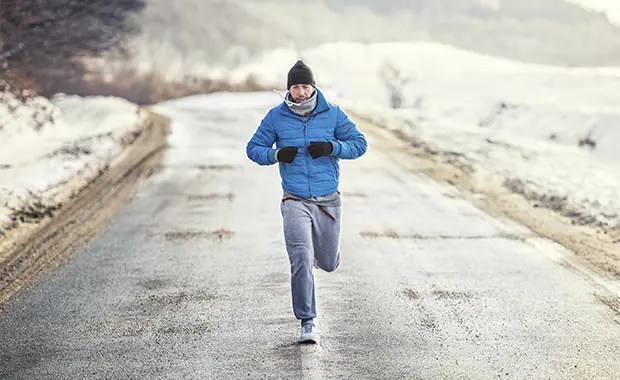
Some athletes embrace winter's chill as a welcome change from exercising in summer's heat. But others complain about hating cold weather.
If that's your stance, remember that exercising with proper nutrition (and layers of dry clothing) offers the opportunity to chase away the chills.
Nutrition Events Near You
After all, an aerobic workout can increase your metabolism by seven to 10 times above the resting level.
This means that if you were to exercise hard for an hour and dissipate no heat, you could raise your body temperature from 98.6 to 140 degrees F. (You'd cook yourself in the process!)
In the summer, your body sweats heavily to dissipate this heat. But in the winter, the warmth helps you survive in a cold environment. Runners can enjoy a tropical environment in their running suit within minutes of starting exercise.
Because food provides the fuel needed to generate this heat, the right sports diet is particularly important for skiers, skaters, runners and other athletes who are exposed to extreme cold.
This article addresses some common questions and concerns about winter and nutrition and offers tips to help you enjoy the season.
For safety's sake, winter athletes should always carry with them some source of fuel in case of an unexpected slip on the ice or other incident that leaves them static in a frigid environment.
Winter campers, for example, commonly keep a supply of dried fruit, chocolate or cookies near by for fuel if they wake up cold in the middle of the night. You want to have an emergency energy bar tucked in your pocket, just in case.
Why Am I Hungrier in the Winter?
A drop in body temperature stimulates the appetite and you experience hunger. Hence, if you become chilled during winter exercise (or when swimming at any time of ye ar, for that matter), you'll likely find yourself searching for food.
Eating "stokes the furnace," generates heat, and helps warm your body.
Food's overall warming effect is known as thermogenesis (that is, "heat making"). Thirty to 60 minutes after you eat, your body generates about 10 percent more heat than when you have an empty stomach.
This increased metabolism stems primarily from energy released during digestion. Hence, eating not only provides fuel but also increases heat production (warmth).
Do I Burn More Calories When I'm Cold?
Cold weather itself does not increase calorie needs. You don't burn extra calories unless your body temperature drops and you start to shiver. (And remember: The weather can actually be tropical inside your exercise outfit.)
Your body does use a considerable amount of energy to warm and humidify the air you breathe when you exercise in the cold.
For example, if you were to burn 600 calories while cross-country skiing for an hour in 0-degree F weather, you may use about 23 percent of those calories to warm the inspired air.
In summer, you would have dissipated this heat via sweat. In winter, you sweat less.
If you are wearing a lot of winter gear, you will burn a few more calories to carry the extra weight of layers of clothes, or skis, boots, heavy parka, snow shoes, etc. The Army allows 10 percent more calories for the heavily clad troops who exercise in the cold.
But the weight of extra clothing on, let's say, winter runners, is generally minimal.
Why Do I Shiver When I'm Cold?
Shivering is involuntary muscle tensing that generates heat and offers a warming effect. When you first become slightly chilled (such as when watching a football game outdoors), you'll find yourself doing an isometric type of muscle tensing that can increase your metabolic rate two to four times.



